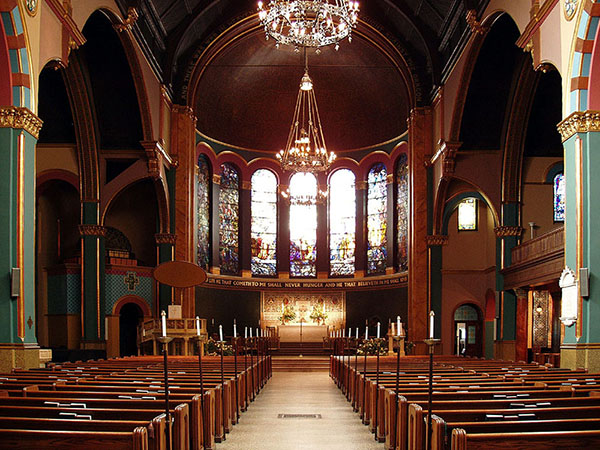Widely known for its stained glass windows by Tiffany and other artists, St. Michael’s Church in New York City has beautiful Tiffany works in other media.
At any time of day or night, the interior of St. Michael’s Episcopal Church in New York City sparkles and glows. The church is best known for its magnificent Tiffany stained glass windows, but beautiful Tiffany works in other media also adorn the church.
Two Centuries on Manhattan’s Upper West Side
St. Michael’s Church has been on the same site at 99th Street and Amsterdam Avenue on the Upper West Side of Manhattan since the beginning of the 19th century, but the current church building is St. Michael’s third.
The first white clapboard church burned in 1854. By the 1880s, St. Michael’s congregation had grown so large that the second church was too small and the current larger church was completed in 1890. Art works by Louis Comfort Tiffany throughout the church enhance the splendor of the innovative combined Romanesque and Byzantine style of the building, designed by influential architect Robert W. Gibson (1854-1927).
St. Michael’s was hardly unique in using the Tiffany firm to increase the beauty of its building: from the late nineteenth through the early twentieth century, scores of American churches, synagogues, public and private institutions commissioned Louis Comfort Tiffany’s interior design firm to adorn their buildings with stained glass windows.
Tiffany employed hundreds of glass makers, metal workers and skilled artisans to meet the demands of these commissions. St. Michael’s seven lancet windows depicting the Biblical story St. Michael’s Victory in Heaven were consecrated in 1895 and are a particularly stunning example of Tiffany stained glass.
1895 Tiffany Altar and Reredos
But St. Michael’s turned to Tiffany for much more than just stained glass windows.
The main altar itself and the reredos (the backdrop behind the altar) were designed by Tiffany. The artistic style of these pieces represented the best and most modern of late nineteenth century ecclesiastical art. The symbols and iconography were ancient and Biblical.
The altar itself is made of shining, deep white marble. Its restrained and elegant front bears a traditional simplified Celtic knot pattern.
From a distance, the Tiffany reredos behind the main altar shimmers like a wall of jewelery. The reredos is made of shining enamel work and mosaics of colored glass and cabochon semi-precious stones. The grape-vine pattern of the enamel work is both lush and orderly. The enamel colors match the stained glass. Warm blond mosaic glass and stones create a frame at the borders of the reredos.
Religious Symbols Shine like Jewels
Directly above the altar are four mosaic roundels containing the traditional iconographic symbols of the New Testament evangelists, Mark the lion, Matthew the man, Luke the ox and John the eagle.
Hanging high above the main nave and in the smaller nearby chapel, Tiffany chandeliers and lamps illuminate the sanctuary. On the main altar, a substantial brass ornamented crucifix designed by Tiffany is flanked by matching brass vases.
1920 Tiffany Beauty in Chapel of the Angels
Immediately after World War I, when St. Michael’s received a remarkably large bequest, one million dollars, from the estate of Elizabeth Furniss Zimmerman, St. Michael’s turned once again to Tiffany for the creation of the gleaming art deco style mosaic reredos behind the small altar in the side Chapel of the Angels.
The partnership between St. Michael’s and Tiffany lasted more than thirty years. The beauty of St. Michael’s for parishioners and visitors alike is embodied in one of the largest collections of ecclesiastical Tiffany art in the United States.
References:
- “St. Michael’s Church,” history booklet, Jean Ballard Terepka (2006)
- The Spiritual Traveler: New York City, Edward F. Bergman, Paulist Press (2001)
- The New-York Historical Society has an extensive collection of Tiffany lamps.
- The Morse Museum in Orlando, Florida contains works by Tiffany and other decorative artists.








